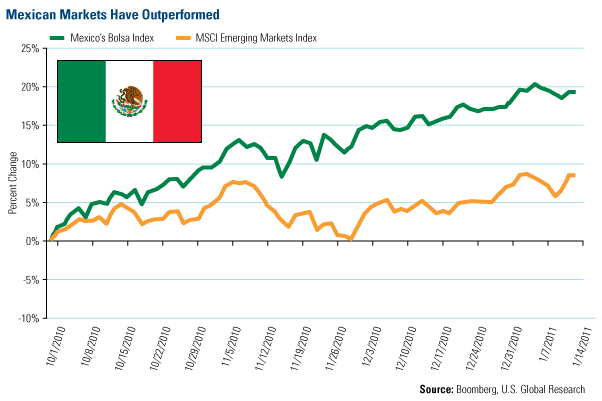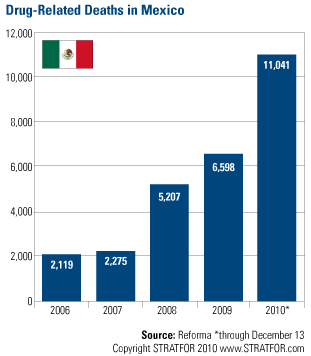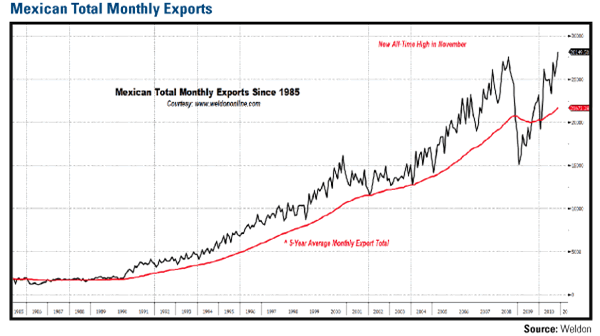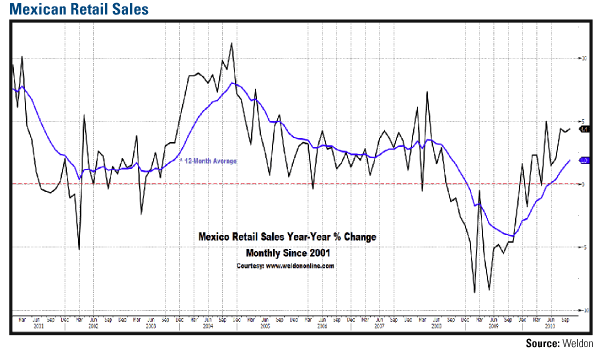Is Mexico a Country on Fire?
Economics / Mexico Jan 18, 2011 - 01:35 PM GMTBy: Frank_Holmes
 Just a three-hour drive from our offices in San Antonio lies an entrance to Mexico, one of the most promising but precarious investment opportunities in global markets. Like stepping on an ant hill, President Felipe Calderon’s war against the drug cartels has created chaos but the country’s economy has proven much tougher than many thought.
Just a three-hour drive from our offices in San Antonio lies an entrance to Mexico, one of the most promising but precarious investment opportunities in global markets. Like stepping on an ant hill, President Felipe Calderon’s war against the drug cartels has created chaos but the country’s economy has proven much tougher than many thought.
San Antonio’s economy has been a direct benefactor of the turmoil as wealthy Mexican citizens have migrated to the area, invigorating the local economy with new entrepreneurial capital and stimulating the high-end real estate market, according to the San Antonio Express-News.

One reason they’ve moved their families here is the increased threat of kidnapping as the faltering cartels look to subsidize their businesses. This isn’t a new phenomenon.
Do you remember 2004’s Man on Fire? In this movie, an ex-CIA agent, played by Denzel Washington, reigns fury on the criminals and corrupt cops responsible for kidnapping a 9-year-old child he was hired to protect. The movie had a major impact on people like me, living so close to the border.
This past weekend, 60 Minutes featured the story of Edelmiro Cavazos, an up-and-coming star in Mexico’s political arena who was kidnapped and murdered by corrupt policeman linked to the drug cartels in August. (Watch the 60 Minutes Piece)
Mexican markets have stood in the face of this turmoil and soldiered on. Over the past three months or so Mexico’s stock market, the BOLSA, has more than doubled the performance of the MSCI Emerging Markets Index, 19.19 percent versus 8.45 percent, respectively.

Sometimes things have to get worse before they can get better.
It’s true—2010 ranks as the deadliest year yet in Mexico’s war against the drug cartels, with 11,041 drug-related deaths as of mid-December, representing a 385 percent increase since 2007, according to global intelligence firm Stratfor.

But that doesn’t tell the whole story. The high number of deaths is likely a result from the capturing and killing of several kingpins which set off a power struggle among the remaining crooks. You might think this has created a modern-day Tombstone but the law enforcement captures have left many of the cartels significantly weaker.
When you look closely at Mexico’s economy, you see that it is well-positioned to benefit from improvement in the U.S.
For starters, Mexico offers some 1.5 times leverage to U.S. markets. This means that if the U.S. GDP is set to grow 3 percent, the Mexican economy can grow 4.5-5 percent.
The key to Mexico’s economy is the United States. Roughly 80 percent of Mexico’s exports are postmarked for the U.S. These are exports like cars, textiles and even electronics. No surprise then that 2010’s U.S. recovery had quite the ripple-effect to Mexico’s export sector.
This chart from Greg Weldon shows that Mexico’s total monthly exports have risen well off of their 2009 lows and are now at record high levels, exceeding those seen before the global recession.

Weldon reports that exports jumped 6.2 percent from October to November last year for a total of $28.2 billion—a 26 percent year-over-year rate of growth. In addition, the growth is broad-based, touching the agricultural, manufacturing, automobile and non-oil sectors.
Another key export for Mexico’s economy is people. The Mexico-U.S. border is the top cross-border migration corridor in the world with an annual flow of 11.6 million migrants. The Russia-Ukraine border ranks second with 3.7 million migrants, according to Scotia Capital.
Roughly 10 percent of Mexico’s population lives outside of Mexico, mostly in the United States. Remittances, or money sent home from a foreign country, from these immigrants represent 3 percent of Mexico’s total GDP. Scotia estimates that there is an 86 percent correlation between remittances and retail sales in Mexico.
This time last year, remittances were at a five-year low because of job destruction in the U.S. which hit the Hispanic population especially hard. The Latin labor force had an unemployment rate of 12.1 percent and 12.5 percent in 2009 and 2010, respectively, according to Scotia Capital. This is significantly higher than the U.S., which saw unemployment rates of 9.3 percent and 9.6 percent over the same time periods.
It’s no surprise then that the recovery in the U.S. job market has led to a recovery in remittances and trickled down into Mexico’s retail sales. This next chart from Weldon shows the year-over-year change in Mexico’s retail sales since 2001. After bottoming in mid-2009, the year-over-year change has remained positive since April 2010.

As of October, retail sales in Mexico posted a 4.4 percent year-over-year change—more than twice the level seen in July, according to Weldon. Weldon also reports that outstanding performing loans—meaning those that are up to date on payments—have just reached a new record high.
As investment managers, we don’t have the luxury of just reading the headlines. There’s always much more to the story. We’re aware of the violence and the threat that it poses. However, contrary to what many people think, it appears investors in Mexico can sit back, pop open a Corona and ride the wave of a U.S. economic recovery.
For more updates on global investing from Frank and the rest of the U.S. Global Investors team, follow us on Twitter at www.twitter.com/USFunds or like us on Facebook at www.facebook.com/USFunds. You can also watch exclusive videos on what our research overseas has turned up on our YouTube channel at www.youtube.com/USFunds.
Please consider carefully the fund's investment objectives, risks, charges and expenses. For this and other important information, obtain a fund prospectus by visiting www.usfunds.com or by calling 1-800-US-FUNDS (1-800-873-8637). Read it carefully before investing. Distributed by U.S. Global Brokerage, Inc.
Standard deviation is a measure of the dispersion of a set of data from its mean. The more spread apart the data, the higher the deviation. Standard deviation is also known as historical volatility. All opinions expressed and data provided are subject to change without notice. Some of these opinions may not be appropriate to every investor. The S&P 500 Stock Index is a widely recognized capitalization-weighted index of 500 common stock prices in U.S. companies. The NYSE Arca Gold BUGS (Basket of Unhedged Gold Stocks) Index (HUI) is a modified equal dollar weighted index of companies involved in gold mining. The HUI Index was designed to provide significant exposure to near term movements in gold prices by including companies that do not hedge their gold production beyond 1.5 years. The MSCI Emerging Markets Index is a free float-adjusted market capitalization index that is designed to measure equity market performance in the global emerging markets. The U.S. Trade Weighted Dollar Index provides a general indication of the international value of the U.S. dollar.
Frank Holmes Archive |
© 2005-2022 http://www.MarketOracle.co.uk - The Market Oracle is a FREE Daily Financial Markets Analysis & Forecasting online publication.



